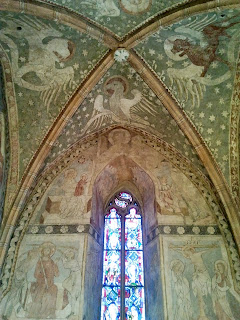

The first photo in this blog entry is of the oldest Fachwerkhaus in Eppingen as well as the entire region itself. Built in 1412, this structure must have fascinating stories to tell from the past of more than 600 years, and it is still lived in today!

It was such a pleasure to arrive in Eppingen and to find only then that this town was on the "Fachwerk map". I have long been attracted to this beautiful form of architecture so it came as a wonderful surprise to me when I encountered so many examples of it still shown in many of the town's buildings. And, to make things even more exciting for this Fachwerk enthusiast, I found myself on a walkway into town from the train station lined with specific examples and explanations of the craft, as you can see below:
 |
| "Fränkischer Mann" (Franconian Man) |
 |
| "Raute" (*Hashtag*) |
 |
| "Wilder Mann" ('Wild Man') |
 |
| Corner piece |
When looking for somewhere interesting and historical to visit and take to photographs, I googled Eppingen, which is about 50 minutes away from me. Instead of reading anything, I just scanned the photos in various websites. Eppingen seemed to have more Fachwerk structures concentrated in one area than other towns, so I decided with that information alone to head on over there on the tram. Eureka!
 |
| "Christbaum" (Christmas tree) |
 |
| "Andreaskreuze" (St. Andrew's Cross) |
 |
| "Alemannisches Weible" (Little Alemannic Lady) |
 |
"Alemannisch Säule"
(Alemannic Column)
|
Without knowing how many half-timbered houses would be awaiting me, I was very pleasantly surprised to learn that Eppingen is quite known for its abundance of examples of Fachwerk, and I was not to be disappointed. It was everywhere. Unfortunately, the temperatures on the day of my visit were about -20C and my iPhone with which I take all my photos was freezing and shutting off. Constantly having to resuscitate the phone ran the battery down and I ended up limited to what is posted here. Alas, you will have to visit there on your own, and preferably in warmer weather, to see the rest of it.
From outside the Epplingen train station, one sees immediately the peaked roofs in the town center which boast these decorative façades; therefore, a map is not required for anyone with opened eyes seeking such Fachwerk architecture.
The house above with the green shutters on the ground floor really trips my trigger. The colors together with the un-uniform wood and plaster facade of the house make it unique and a pleasure to admire.
 |
| View of the Piper's Tower, one block from the Market Place, which is located in the center of town. |
D O O R S


 |
| An odd favorite |
For some reason, out of all the structures I saw in Eppingen, this house (above) attracted me the most. Why, I don't really know, except that maybe since it appeared un-restored, my imagination was able to play more with whatever historical version of the story I wanted to give it.
The tall, church-like window on the upper section was intriguing to me. Why is it there? Was it original to the house? So often one can see sections that have been plastered over or bricked in where windows either once were or had been planned and not realized. But, this peaked window was curious to me. Perhaps doors had once been there for hoisting storage or goods into the upper floors. Who knows.
Together with the church (to the right, just out of the photo), these two houses make up a small church courtyard. The painting across the front of the house between the floors is the Totentanz, or Dance of Death. I would advise googling "Totentanz" or "The Dance of Death". You will find a variety of them. Perhaps even a version of the one in the photo above.



Above can be seen the Catholic Church of Our Lady (Old City Church), built in 1435, expanded between 1972 and 1974. Part of the church was built in the 12th and 13th centuries.
Getting there
From Karlsruhe Main Station:
Local trains run from the front of the station or one of the platforms within the station. The S31/S32 runs from within, but you will need to transfer at the next stop which is Karlsruhe-Durlach station (about 5 minutes away from KA main station).
If you leave on the S4 from outside the front of Karlsruhe's main station, you will not need to change trains, but the journey will take you 8-15 minutes longer, as it must go through Karlsruhe city and all stops in between to get to Durlach, where you would change trains if you take the S31/S32 from within the station. Your choice. The ticket cost is the same.
In total, the trip is anywhere from 58 minutes to 1:15 minutes, depending on the local train you choose to begin the journey.
Get off at Eppingen station (Bahnhof), and the Old Town will be visible to you toward the left once you are out in front of the train station building itself. Not even a 10 minute walk.
By car: get a navigator or a good old map because I only travel by train, bus, plane, or donkey.
__________
Safe travels and make sure you have enough battery in your mobile phones to take all the photos you desire.


















































